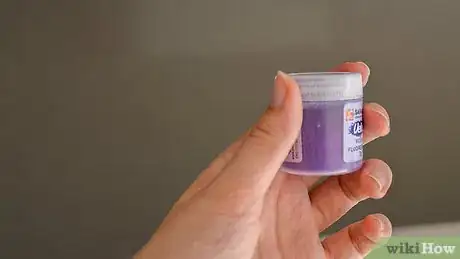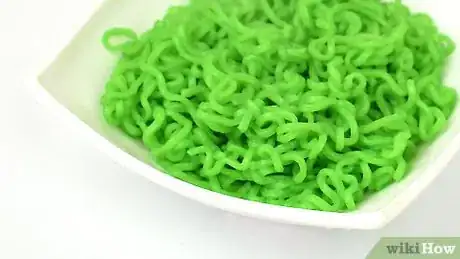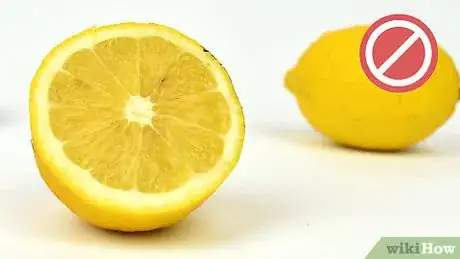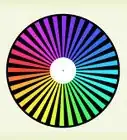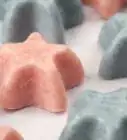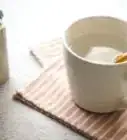This article was co-authored by wikiHow staff writer, Jessica Gibson. Jessica Gibson is a Writer and Editor who's been with wikiHow since 2014. After completing a year of art studies at the Emily Carr University in Vancouver, she graduated from Columbia College with a BA in History. Jessica also completed an MA in History from The University of Oregon in 2013.
There are 9 references cited in this article, which can be found at the bottom of the page.
The wikiHow Video Team also followed the article's instructions and verified that they work.
This article has been viewed 61,734 times.
Learn more...
Bright food is fun food! To make your cakes, cookies, and confections eye-catching, work with liquid, gel, powder, or natural food coloring to make their colors really pop. Have fun blending your food coloring to create custom colors or to dye food that's usually pale. By experimenting, you'll find your favorite food coloring to work with and have plenty of bold colored food to show for it!
Steps
Choosing Food Coloring
-
1Pick up a package of liquid food dye for a quick way to add light color. You've probably seen a small package of liquid food dye at the grocery store or supermarket. Each inexpensive package contains a non-toxic bottle of synthetic red, yellow, blue, and green dye. It's easy to mix these dyes to make a custom color for dying your food, especially if you'd like a pale or pastel color.[1]
- Keep in mind that if you want a deep color, you'd have to use a lot of liquid dye, which could change the texture of your food.
-
2Choose gel paste if you want to make a rich color. Gel paste is another synthetic dye but it's blended with water, glycerine, and corn syrup to make a thick, concentrated paste. Buy a small pot of gel paste if you'd like a little dye to go a long way.[2]
- You can find gel paste at craft supply stores, cooking stores, or online. Look for food-safe gel paste that's labeled non-toxic.
- Keep in mind that gel paste is usually messier to work with than liquid dye.
Did You Know? Gel paste is sometimes called icing color or concentrated gel.
Advertisement -
3Buy powdered dye for the most variety of uses. You can find small jars of powdered dye at craft supply stores. Since this dye isn't combined with water, glycerine, or corn syrup, it lasts a long time and is great to add to food that you don't want to dilute. It's also easy to get a bold or dark color using powdered dye.[3]
- If your craft store doesn't carry powdered dye, you can buy it online. Choose a powder that says it's food-safe and non-toxic.
-
4Make your own natural food coloring for rich, subtle colors. If you don't like the idea of buying synthetic dyes to add to your food, work with brightly colored fruits and vegetables. Depending on the produce, you can juice it, boil it, or dehydrate it before grinding it to get a pigment for dying your food. You can make natural food coloring from:[4]
- Beets
- Carrots
- Red cabbage
- Onions
- Spinach
- Pomegranates
- Berries (strawberries, blueberries, blackberries)
Tip: You can also use brightly colored spices to color food. For example, lots of rice or curry dishes are colored with turmeric or saffron to give them a yellow or orange color.
Selecting Food to Color
-
1Stir coloring into batter for baked goods. If you're making muffins, cake, cupcakes, pancakes, or waffles, mix any type of food coloring into the batter before you bake the food. You should add the dye to the wet ingredients so you don't accidentally overmix the batter which would make the food tough.[5]
- The color of some baked goods might change as they bake, so batter that looks really bright may end up being a shade paler after it cooks.
-
2Create colorful frostings or icings with food coloring. You can easily color buttercream or icing with any type of food coloring. To get a pale color, use liquid food coloring, for instance, or try gel to get a bolder color. Add the food coloring along with any extracts or flavorings.
- If you'd like to mix food coloring into whipped cream, use gel or powdered food coloring since liquid food coloring could make it harder to beat the whipped cream.
-
3Add food coloring gel into fondant or gum paste. If you'll be covering a cake with a smooth layer of fondant, customize the color before you roll it out. Make a well in the center of the fondant and dab a little food coloring gel into it. You can keep folding the fondant over and over until the color is incorporated.[6]
- It will take a little effort to spread the food coloring gel evenly through the fondant, so don't give up before the color is completely mixed in.
-
4
Mixing the Coloring into Food
-
1Reduce the acid in the food you want to dye. Acidic ingredients, such as lemon juice, cream of tartar, and buttermilk, can react with the food coloring to create an unusual tint. Try to substitute or reduce the acidic ingredient so the colors stay true.
- For example, if you're dying a buttermilk frosting violet, the acid in the buttermilk will make the color appear blue. To prevent this from happening, use milk instead of buttermilk.
-
2Stir liquid food coloring in drop by drop. It's easiest to add liquid food coloring to foods that are pale or white since the dye won't be competing with other pigments. Squirt 1 or 2 drops and mix the dye into your food. Then, keep adding food color 1 drop at a time until the food is the color you'd like.[8]
- Remember that you can create colors by combining drops of the red, blue, green, and yellow dye you bought.
Did You Know? You can make these colors by mixing:
1 drop of red with 2 drops of yellow = orange
1 drop of blue with 3 drops of red = purple
1 drop of red with 1 drop of yellow and 4 drops of blue = dark green
2 drops of red with 4 drops of yellow = peach
6 drops of red with 6 drops of yellow and 4 drops of blue = brown -
3Stir food coloring gel into food to create bold color. Since the gel is more concentrated than liquid food coloring, start coloring food by dipping a toothpick into the gel and dabbing it into the food. Once you've incorporated it, you can continue to add just a tiny bit at a time. Remember that it's easier to add more than to correct food that's too dark.[9]
- Gel food coloring is great for dying food red or black since these are difficult colors to make using liquid food dye.
- If you're dying a large quantity of food, such as cake batter, gel paste is a good choice because it's so bright.
-
4Mix a little powdered dye directly into batter or brush it on top of food. If you're dying foods that shouldn't have added liquid, such as chocolate, meringues, or macarons, mix a little powder right into the batter. Keep adding powder until the batter is as bright as you want it. You can also stir a little powder into a few drops of water to make a strong paint that you can brush over cookies or fondant-covered cake.[10]
- It's better to go slowly when you add the powder since it's easy to make a color that's too dark.
Community Q&A
-
QuestionHow can I make green muffins for St. Patrick's Day?
 Community AnswerThe best thing to do is use some green food gel in the batter. It is typically cheap, flavorless, and very pigmented.
Community AnswerThe best thing to do is use some green food gel in the batter. It is typically cheap, flavorless, and very pigmented. -
QuestionIf I want to add orange or yellow food coloring to kernel corn with butter and cream cheese, do I add it while cooking or when it is finished?
 Community AnswerWhile cooking; it works a lot better. If you do it after, it just won't look or taste good.
Community AnswerWhile cooking; it works a lot better. If you do it after, it just won't look or taste good. -
QuestionCan you put food coloring in milk?
 Community AnswerYes, it will not cause a chemical reaction (other than changing the color).
Community AnswerYes, it will not cause a chemical reaction (other than changing the color).
Warnings
- Studies continue to research links between artificial food coloring and health issues, such as attention-deficit hyperactivity disorder and cancer.[12]⧼thumbs_response⧽
References
- ↑ https://www.tasteofhome.com/article/types-of-food-coloring/
- ↑ https://www.thekitchn.com/heres-a-guide-to-food-coloring-types-and-how-to-use-them-buying-guides-from-the-kitchn-213409#comments-213409
- ↑ https://www.thekitchn.com/heres-a-guide-to-food-coloring-types-and-how-to-use-them-buying-guides-from-the-kitchn-213409#comments-213409
- ↑ https://food52.com/blog/16265-how-to-make-all-natural-food-dyes-from-ingredients-in-your-kitchen
- ↑ https://www.myrecipes.com/ingredients/how-food-coloring-affects-baked-goods
- ↑ https://thebearfootbaker.com/2015/04/color-fondant/
- ↑ https://www.allrecipes.com/recipe/59280/saffron-rice/
- ↑ https://thedecoratedcookie.com/all-about-food-coloring/
- ↑ https://www.tasteofhome.com/article/types-of-food-coloring/


